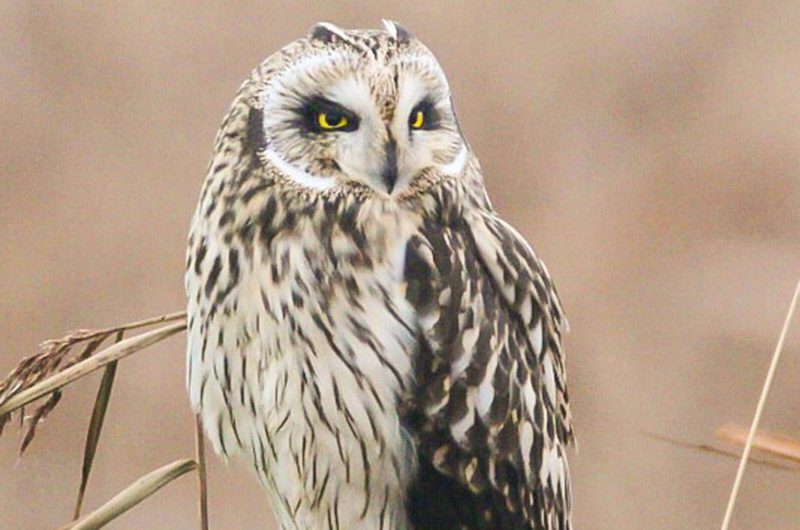LandPKS Learning
Habitat Hub

Short-Eared Owl
Short-eared owls can travel long distances over vast expanses of ocean. Witnesses have reported seeing these owls descending on ships hundreds of miles from land.
Asio flammeus
Identification
Short-eared owls are one of the most widespread owls in the world and about the size of a crow, at 13-16 in/34-43 cm long. The “ears” mentioned in their name are difficult to see. The wings are broad and the tips are smoothly rounded, and the tail is short. They are fairly uniform in pattern, brown and white streaked throughout and solid white under the wing, seen during flight. The face is pale with yellow eyes accentuated by black outlines.
Observation Tips
Short-eared owls hunt during the day, unlike most owls. They are also considered a partial migrant. In North America, many birds breed throughout Canada, New England, and winter in the southern U.S. They arrive on their breeding grounds in April in the far north and head south for winter as late as November. Like most birds of prey, they typically will have a nest with eggs by March. There are also resident birds in the northern Midwest/West, which can be seen year-round. Look for these owls in grasslands and open areas, where they perch in low trees or on the ground. Populations fluctuate yearly based on variation in small-mammal populations.
Interesting Fact
Short-eared owls can travel long distances over vast expanses of ocean. Witnesses have reported seeing these owls descending on ships hundreds of miles from land.
Ideal Habitat
Short-eared owls inhabit a variety of open expanses of prairie and other grassland habitats along with shrub-steppe, tundra and agricultural areas. They are also seen in high arctic to mid-latitudes and on offshore islands. On the Great Plains, they prefer to nest within large patches of relatively tall, 12-24 in/30-60 cm, dense, 30-50% herbaceous cover, grassland with a low shrub component, <5%. They make their nests on the ground, with the nest bowl scraped out by the female and lined with grass.

Range map provided by BirdLife International
Management Activities that Benefit Species – Best Management Practices (BMPs)
In tallgrass areas, burning or mowing every 3-5 years is recommended to maintain habitat for voles, the principal small rodent prey of short-eared owls. Collaborate with ranching and farming advocates to maintain native grasslands and rangeland. Maintain a mosaic of grasslands and wetlands so that some units are available for nesting. To prevent mortality or injury from collisions with fences, remove unused fences. Increase visibility of fences by hanging fence markers, such as those used for greater sage-grouse.
Management Activities to Avoid
Avoid conversion of native grasslands to cropland and residential development. Avoid hunting mammals with lead bullets, because owls are susceptible to secondary poisoning from eating dead mammals with lead shot. Similarly, avoid poisoning small mammals which can also have a negative secondary injury to owls.
Other Species that Benefit from Similar Habitat Management
Other wildlife that may benefit from habitat management for short-eared owl include, pronghorn antelope, northern harrier, lark bunting, grasshopper sparrow and western meadowlark.
Download
Download the Short-eared Owl factsheet
Other Resources
BirdLife International and Handbook of the Birds of the World. 2019. Bird species distribution maps of the world. Version 2019.1. Short-eared owl.
The Cornell Lab of Ornithology. Birds of the World (Short-eared owl).
The Cornell Lab of Ornithology. All About Birds (Short-eared owl).
NatureServe. 2019. NatureServe Explorer: An online encyclopedia of life [web application]. Version 7.1. NatureServe, Arlington, Virginia. Short-eared owl.
Dechant, J. A., M. L. Sondreal, D. H. Johnson, L. D. Igl, C. M. Goldade, P. A. Rabie, and B. R. Euliss. 1999 (revised 2002). Effects of management practices on grassland birds: Short-eared owl. Northern Prairie Wildlife Research Center, Jamestown, ND. 33 pages.
Photo credit: Joe M. Devereux/Flickr
Mobile App | Data Portal | Knowledge Hub | Habitat Hub | Learning Collections | Blog | About | Contact | Support



